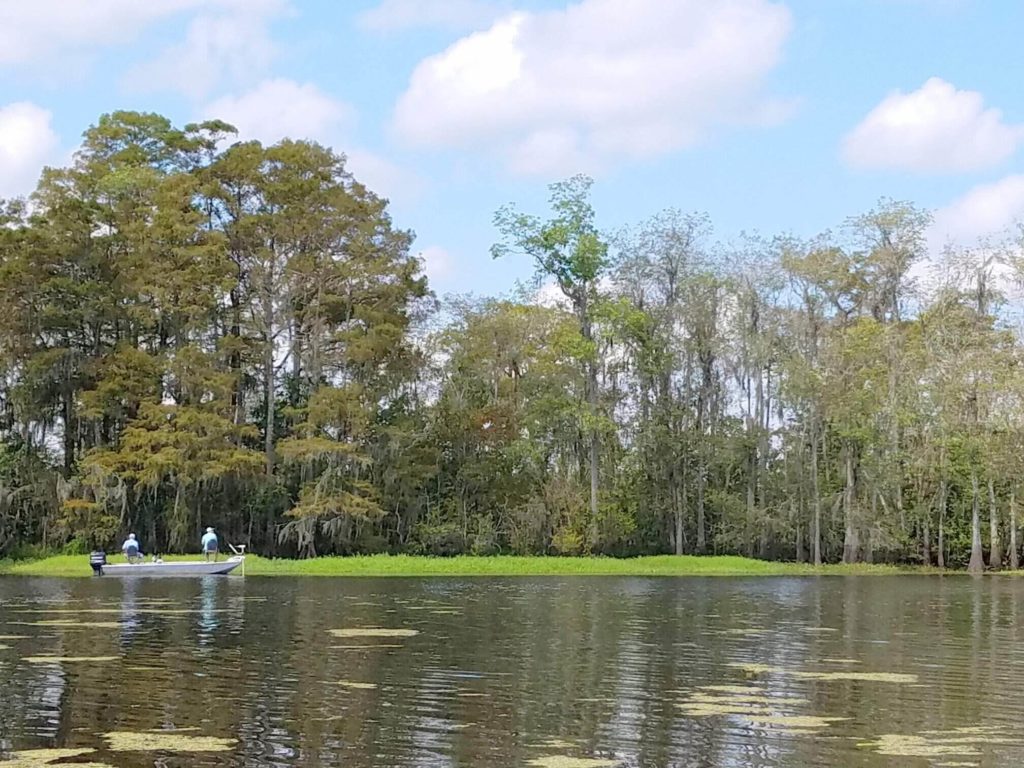Written by Wendy Billiot for Louisiana Wildlife Federation
Idling slowly among the cypress knees in a shallow-draft boat, one can only imagine what the Maurepas Swamp would have looked like 100 years ago—before the Great Flood of 1927, before the leveeing of the Mississippi River, and before the virgin cypress were cut down and hauled out to be milled for house and boat building. While the still-remaining second-growth cypress emanate a beauty and history of their own, what kind of story will the trees tell 100 years from now?
The Maurepas Swamp is the second largest area of forested wetland in Louisiana and encompasses approximately 140,000 acres of baldcypress-tupelo swamp southwest of Lake Maurepas. Since the Great Flood of 1927, the mighty Mississippi has been levied and dammed in order to control the river’s flow and to keep it in its current lobe. Without the historical input of riverine sediment and fresh water from the Mississippi into the swamp, degradation has taken a toll on the baldcypress-tupelo forests, marshes, and water quality.
Despite a noticeable decline, sportsmen and sportswomen continue to hunt and fish in the Maurepas Swamp. The most sought-after game in the swamp are the white-tailed deer, squirrels, and rabbits. Historically, the swamp was a winter haven for migratory waterfowl, making it a duck hunter’s paradise. However, local recreational hunters have witnessed extensive negative changes in the Maurepas Swamp over their lifetimes.
James “Goosie” Guice, who grew up fishing and hunting the waters around Maurepas, recalls experiencing some of the best duck hunting in the state within the swamp at one time. Due to the change in hydrology and invasive plant life, decreasing numbers of ducks spend time in the Maurepas Swamp during the winter months. Guice shares his opinions about reintroducing the river into the swamp: “There is no doubt that allowing the Mississippi’s water into the swamp will be a shot in the arm for this environment. Done correctly, that could not only help the water quality and forest, but the waterfowl should return to some degree along with frogs, crawfish, fish, and all other critters of the earth that require clean fresh water.” Guice looks forward to the day the ducks return and his great-grandchildren follow in his duck-hunting footsteps in the Maurepas Swamp.
Lyle Johnson, another user of the Maurepas Swamp, has a 64-year relationship with the area. While he has hunted and fished here for many years, fishing is his real passion, and from his boat, he has seen firsthand the negative impacts the lack of freshwater from the river has had on the swamp in his lifetime. As a proponent of a river reintroduction project from its inception, Johnson can’t wait for the project to get underway and looks forward to its completion. “The rich Mississippi River water has the potential not only to restore the swamp but to build it up and create new growth. Fresh water brings life everywhere it goes, so the benefit to wildlife and fish will be staggering.”
Troy Schexnayder, now 58, has been spending time at the family camp in the Maurepas Swamp since he was in diapers. “I remember when the deer camps out here were a culture all their own. They’d have 10 or 20 boats docked in front of the camp and 30 or 40 men drinking coffee early in the morning, swapping stories. Then, they’d get their dogs and go run the deer until the afternoon. That’s a thing of the past, though. The swamp has changed so much.” Of all the activities that Schexnayder still takes part in out in the swamp, fishing for largemouth bass is his favorite. It is his hope that this freshwater diversion project will restore prime habitat for his favorite game fish.
Mark Shurtz has stomped around in the Maurepas Swamp since the age of ten, when his shoes kept his feet dry almost anywhere he walked in the swamp. The most notable change he’s experienced over the past 15-20 years is the disappearance of ridges in those places where he once walked in his Keds. Nowadays, chest waders won’t even get him to those same places. His belief about reintroducing the river into the swamp is multi-faceted, but mainly he’s looking forward to the return of native vegetative species and says, “The River Reintroduction project should lead to ‘sandbar’ areas that will begin to be populated by native species such as black willow and swamp maple; and as time goes on, the hardwoods should begin to return.”
These are just a few of the stories told by folks who have spent time hunting and fishing in the Maurepas Swamp and have a desire to see it restored to its former glory. With the implementation of the Mississippi River Reintroduction into the Maurepas Swamp project, these sportsmen and women, and others yet to come, will reap the benefits of a well-managed and maintained swamp. The project will funnel much-needed nourishment from the river back into the swamp where it will ensure that future outdoorsmen and women will have many more hunting and fishing tales to share 100 years from now.

